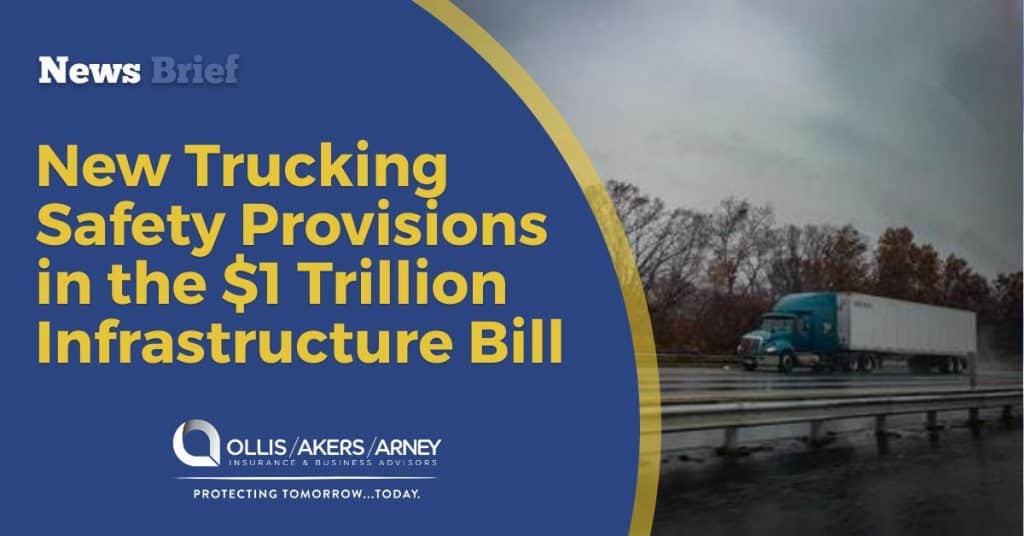The White House’s new $1 trillion infrastructure bill was signed into law on Nov. 15, 2021. This bill contains several provisions affecting commercial motor vehicle (CMV) safety and operations. These provisions can be found in the Surface Transportation Act of 2021 part of the bill. This article outlines some of the provisions within the Surface Transportation Act of 2021 that impact CMV safety.
Apprenticeship Pilot Program
The bill requires the Federal Motor Carriers Safety Administration (FMCSA) secretary to establish a pilot program within 60 days that allows employers to create apprenticeship programs for CMV drivers. This program is to be three years in length and must allow up to 3,000 drivers under the age of 21 to operate CMVs. These drivers will have to complete 400 hours of training, which includes 240 hours behind the wheel in interstate commerce driving. Entry-level training will also be included, thus allowing drivers to obtain their commercial driver’s licenses (CDLs).
Driver Compensation
The bill also requires the FMCSA to determine how CMV driver compensation affects safety within the next year. The FMCSA is required to study this comparison with the Transportation Research Board.
Out-of-Service Enforcement
When CMV drivers are placed out of service at the state level, some still continue to operate in interstate commerce. To prevent this from occurring, the bill requires the FMCSA to develop and publish initiatives to deter CMV drivers from operating after being taken out of service.
Providers of Recreational Activities
Under the bill, a new exemption must be enacted for CMVs used for recreational activities. Any nine- to 15-passenger CMVs operated by someone who provides recreational activities and offers transportation within 150 air miles of the loading point from one state to another is considered to be in accordance with applicable state law.
Crash Causation
Further, the bill requires the Department of Transportation (DOT) to carry out a comprehensive study to determine the causes of and contributing factors for crashes involving CMVs. In addition, the study will identify data requirements and collection that can be used to improve evaluation of future crashes involving CMVs, monitor crash trends and develop effective safety improvement policies and programs.
Promoting Women in the Trucking Workforce
As a result of women being significantly underrepresented in the trucking industry—holding just 24% of all transportation and warehousing jobs and representing only about 7% of truck drivers—the White House wants to create more opportunities for women to hold careers in trucking.
As such, the bill requires the FMCSA to establish a “Women of Trucking Advisory Board” within nine months. This board will review and report on policies that provide education, training, mentorship or outreach to women in the trucking industry.
State Inspection Programs for Passenger-Carrier Vehicles
The bill also states that the FMCSA will have one year to solicit additional comments on state inspection programs for passenger-carrier vehicles. This commentary will be to determine if there should be a final rule issued for self-inspections. The FMCSA must consider the impact of continuing to allow self-inspections to satisfy periodic inspection requirements on the safety of passenger carrier operations.
Truck Leasing
Within six months, the bill requires the FMCSA to establish a “Truck Leasing Task Force” in consultation with the Department of Labor. This task force will review the terms of common truck leasing arrangements and determine whether those arrangements are equitable and safe. There will be 10 members in the task force. Each member will be a representative from different groups, businesses or organizations.
Automatic Emergency Braking
The bill gives the DOT two years to implement a motor vehicle safety standard that requires any CMV (CDL-class) manufactured after the standard’s effective date to be equipped with automatic emergency braking systems. Once this standard has been introduced, a study must be conducted to determine if automatic emergency braking systems should be required on smaller CMVs as well.
Underride Protection
The bill also requires the DOT to conduct additional research on the design and development of rear- and side-impact guards. An “Advisory Committee on Underride Protection” must be created to provide advice and recommendations on any safety regulations that may help reduce underride crashes and related fatalities.
Electronic Logging Device Oversight
Under the bill, the FMCSA has six months to submit a report to Congress that analyzes the costs and effectiveness of electronic logging devices (ELDs). In this report, the FMCSA must detail the processes used to review ELD logs and protect proprietary and personally identifiable information. Also, the report must detail how an operator may challenge or appeal a violation notice issued by the FMCSA relating to ELDs.
Agriculture Commodity Hours-of-Service Exemption
Lastly, the bill expanded the “agricultural (ag) commodity” hours-of-service exemption to apply within a 150 air-mile radius of a load’s final destination. This reflects a change, as the original rule allowed livestock drivers to be exempt from hours-of-service requirements when they were operating within 150 air miles of the source of the livestock.
Taking all of this into account, motor carriers should continue to review the FMCSA regulations to make sure they remain up to date on any changes under the Surface Transportation Act of 2021.
For additional industry updates and risk management resources, contact us today.
This article is intended for informational purposes only. © 2021 Zywave, Inc. All rights reserved.


